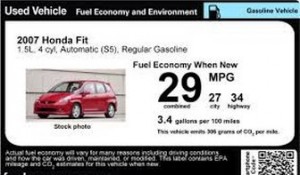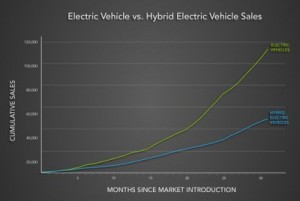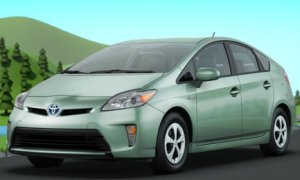 While alternative fuel vehicles started noticeably showing up in fleets in the early 1990s, they haven’ t become significant in numbers or budgets until recently. Now fleets are acquiring all types of green vehicles, and that includes government fleets, corporate, service and delivery, utility, trucking, car rental, and car sharing companies. They’re also continuing to buy the most fuel efficient vehicles on the market, but alternative fuels have more importance now than 20 years ago when Clean Cities started up.
While alternative fuel vehicles started noticeably showing up in fleets in the early 1990s, they haven’ t become significant in numbers or budgets until recently. Now fleets are acquiring all types of green vehicles, and that includes government fleets, corporate, service and delivery, utility, trucking, car rental, and car sharing companies. They’re also continuing to buy the most fuel efficient vehicles on the market, but alternative fuels have more importance now than 20 years ago when Clean Cities started up.
WEX Inc., formerly known as Wright Express, just sponsored a new whitepaper on the topic – “Going Green, Saving Green: A Fleet Manager’s Guide to Alternative Fuels Best Practices.” WEX is the leader in fleet fueling payment cards systems, and is now bringing that over to electric vehicle charging and natural gas refueling stations. It’s interesting to see a company like WEX release this type of whitepaper – the importance of alternative fuel vehicles has gained enough presence to inspire a whitepaper. It’s reminiscent of NADA Used Car Guide recently releasing a special report on resale value trends for the Nissan Leaf and Chevy Volt – after having ignored the issue for quite a long time.
The WEX paper provides fleets with best practices for cost-effective implementation of alternative fuels in a fleet. While media primarily focus on consumer behavior with green vehicles, this paper asserts that fleets are much better positioned to use alternative fuels – their choices are premeditated, unlike consumers’. They’re usually traveling along predetermined routes and can stop for recharging and refueling at given points. That makes it much more viable to plan strategically and contain costs. Here are five recommended tips on making it work….
#1: Know the station coverage in your area.
US government agencies have made significant infrastructure investments, bringing up the number to 11,800 stations – of which about 6,000 are charging stations. About 82% of alternative fueling sites are accessible to the public. The Dept. of Energy offers a comprehensive directory of charging/fueling sites around the country.
#2: Compare historical fuel costs.
Starting in 2008, the commonly used fleet industry terminology for spiking gasoline prices was “fuel price volatility.” It was quite volatile that year, which shot up fuel costs for fleets and hurt vehicle financing and remarketing programs. Switching over to alternative fuels can bring price stability to fleets, though they do have to build in the conversion costs and lifecycle costs of choosing hybrids and EVs over fuel efficient gasoline and diesel engine vehicles.
#3. Think in terms of total ownership cost.
While green vehicles tend to sell for a premium price over typical internal combustion engine vehicles, total cost of ownership can be very appealing – especially for fleets putting a lot of mileage on their vehicles. Fleets tend to study four cost categories: capital costs; maintenance costs; end of life recycling and replacement costs; and indirect costs.
#4: Find and use tax credits wherever you can.
It goes without saying that incentives like federal tax credits and state rebates are very attractive for fleets – and there are a lot of these offerings to choose from now. Calstart encourages fleets to stay informed on state voucher programs to reduce ownership costs. The DOE offers a useful site to find out about the latest federal and state programs. Keep in mind that you need to have good fleet reporting mechanisms in place to cash into these incentives.
#5. Think holistically about fleet fuel costs.
This is where experience will come to play. It depends very much on the regional location of the fleet – in some areas like California, the infrastructure is more solidly in place for natural gas fueling and EV recharging than in most other states. A fleet might have very limited routes with plenty of downtime, making EVs with Level 2 chargers a good buy. Other fleets may choose hybrids and fuel efficient cars and crossovers, depending on their mileage and coverage area and the available infrastructure in that area.
Stay tuned for more specialized reports on green vehicles and infrastructure to be released. These reports are likely to focus on the US and other key economic markets – China, India, Japan, Korea, Brazil, European Union, and Canada being the most important. Eventually, the economic impact of green vehicles and fueling will grab more attention as the numbers grow and the industry adds more layers to operations.
 Looking for a profitable used vehicle market segment to reach? How about green cars – hybrids, electric vehicles, and fuel efficient vehicles? Franchised and independent dealers are seeing a lot of used inventory on the market today, and some of it, especially trucks, is seeing strong pricing. What we’re seeing though, such as in Manheim’s latest report, is that dealers are doing well by selling lots of used vehicle the right way. Prices might be down on small, fuel efficient cars and hybrids, but all things considered, they’re not bad – and selling a lot of them can be profitable.
Looking for a profitable used vehicle market segment to reach? How about green cars – hybrids, electric vehicles, and fuel efficient vehicles? Franchised and independent dealers are seeing a lot of used inventory on the market today, and some of it, especially trucks, is seeing strong pricing. What we’re seeing though, such as in Manheim’s latest report, is that dealers are doing well by selling lots of used vehicle the right way. Prices might be down on small, fuel efficient cars and hybrids, but all things considered, they’re not bad – and selling a lot of them can be profitable.


